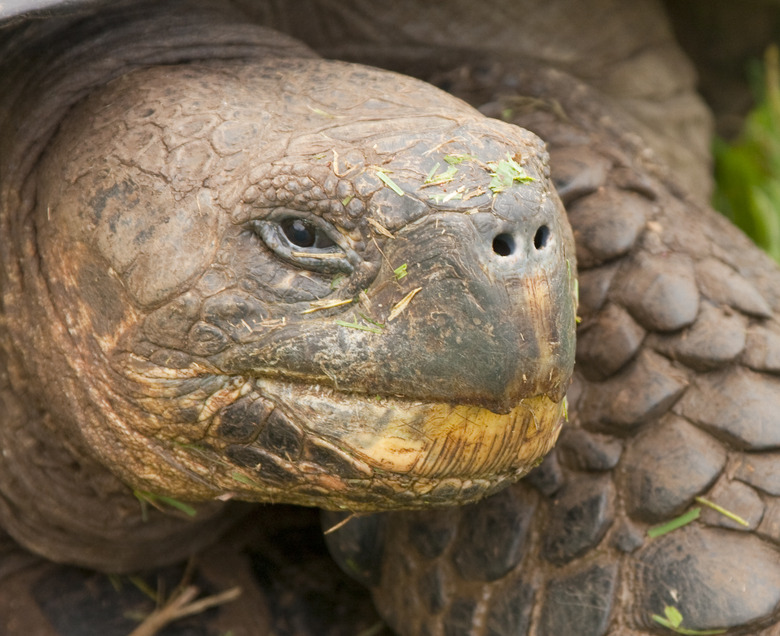What Animal Lives The Longest?
Even if it escapes spiders and flyswatters, a housefly survives on the order of mere weeks. Indeed, we measure the lifespan of many creatures – especially tiny ones – in months. Certain members of the animal kingdom, though, fall far to the other side of the longevity scale, capable of living for centuries or even millennia. Against certain sea sponges or marine clams, the oldest human is but a fresh-faced upstart.
TL;DR (Too Long; Didn't Read)
While some animals live days or weeks, some live for centuries or millennia. The animals with the longest life span tend to be invertebrates, including the mud clam, which can live at least 500 years, and the jellyfish, which can live indefinitely, barring injury, cycling between adult and juvenile stages. Among vertebrates, the longest life spans are much shorter, but there are still some species, including the bowhead whale and the giant tortoise that can live at least 100 to 200 years. Among primates, humans live the longest.
Invertebrate Champions
Invertebrate Champions
Research suggests that hexactinellid sea sponges in Antarctic waters may live more than 10,000 years. Meanwhile, by analyzing their chitin- and keratin-based skeletons, scientists dated deep-sea black corals in the Gulf of Mexico, retrieved from depths of at least 300 meters (984 feet), at 2,000 years old. The mud clam, or ocean quahog, a deepwater bivalve of the North Atlantic, can live at least a half-millennium. Most head-spinning of all, though, is the jellyfish, which appears to possess the capability to live indefinitely – if not killed by predators or infection – by cycling back and forth between juvenile and adult stages. The functionally immortal jellyfish is perhaps the answer to questions about which animal lives the longest.
Venerable Vertebrates
Venerable Vertebrates
Animals with backbones don't quite compare in the lifespan department with invertebrates, but nonetheless include some impressively durable species. The bowhead whale, a heavy-bodied baleen whale of Arctic waters, may live at least two centuries. Inuit hunters found 19th-century harpoon points in the flesh of these whales in the 2000s. A 2007 Nature article report that the Inuit have long claimed, correctly, as scientific studies now bear out, that bowhead whales can live the equivalent of "two human lifetimes." Giant tortoises, various rockfish, lake sturgeon and a primitive lizard called the tuatara may all live 100 to 200 years or even longer.
Humans and Other Primates
Humans and Other Primates
The oldest living person on record was a Frenchwoman named Jeanne Calment, who died in 1997 at age 122. While such lifespans certainly aren't the norm, human beings are impressively long-lived compared with most other mammals: In 2012, the World Health Organization reported the global average human life expectancy at birth was 70 years. While this does not make humans the longest living mammal, no other primate is known to live as long as humans. Monkeys such as the black-faced spider monkey and olive baboon, and great apes such as chimpanzees and gorillas may thrive for four or five decades. Among tarsiers, monkeys, apes and human beings – but not lorises or lemurs – larger brain size appears to be correlated with longer lifespan.
Physiological Traits Promoting the Longest Life Span
Physiological Traits Promoting the Longest Life Span
The biology of aging in humans and other organisms is still rich in mystery, but scientists have identified some potential physiological characteristics and processes that may dictate a longer life for certain creatures. At a basic level, a slower metabolism, such as that exhibited by some cold-water organisms like the bowhead whale and Antarctic sea sponges, may be conducive to an extended lifespan.
A study on the mud clam indicated that the mollusk's longevity may correlate with reduced levels of lipid oxidation in the membranes of its mitochondria, a biochemical process apparently associated with cellular aging in some organisms. The mechanism by which the adult immortal jellyfish prolongs its life involves reverting its cells back to the younger phases of cyst and colonial polyp, a turning-back of the clock that seems to be triggered by survival threats such as diminished food supplies or physical injury.
References
- Alfred Wegener Institute for Polar and Marine Research: The Role of Sponges in High-Antarctic Carbon and Silicon Cycling: A Modelling Approach
- U.S. Geological Survey: 2,000 Year-old Deep-sea Black Corals Call Gulf of Mexico Home
- Nature: Patented Harpoon Pins Down Whale Age
- National Geographic News: "Immortal" Jellyfish Swarm World's Oceans
- World Health Organization: Global Health Observatory — Life Expectancy
- National Primate Research Center: The Life Spans of Nonhuman Primates
- Proceedings of the National Academy of Sciences: Brain Weight and Life-span in Primate Species
- Aging Cell: The Extreme Longevity of Arctica islandica Is Associated with Increased Peroxidation Resistance in Mitochondrial Membranes
Cite This Article
MLA
Shaw, Ethan. "What Animal Lives The Longest?" sciencing.com, https://www.sciencing.com/what-animal-lives-longest-4572512/. 25 July 2018.
APA
Shaw, Ethan. (2018, July 25). What Animal Lives The Longest?. sciencing.com. Retrieved from https://www.sciencing.com/what-animal-lives-longest-4572512/
Chicago
Shaw, Ethan. What Animal Lives The Longest? last modified March 24, 2022. https://www.sciencing.com/what-animal-lives-longest-4572512/
